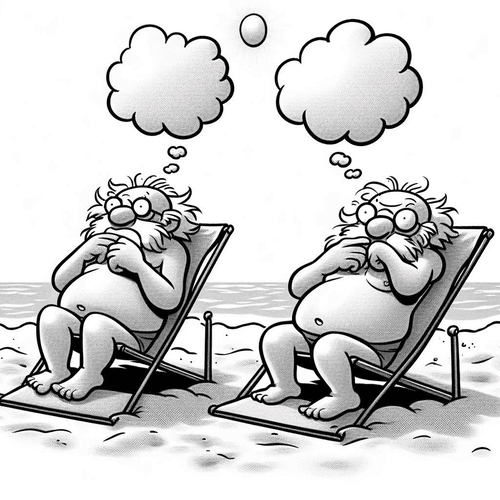Nature’s Perfect Motor: How the Bacterial Flagellum Defies Evolution
In the microscopic realm of bacteria, there exists a marvel of engineering that has left scientists astounded and Darwin’s theory struggling for explanations. The bacterial flagellum—a microscopic motor that propels bacteria through liquid environments—demonstrates engineering principles so advanced that our best human designers can only look on in amazement.
But it’s not just the flagellum’s raw complexity that challenges conventional evolutionary explanations—it’s its specified complexity. While complexity alone may arise through random processes (like the intricate patterns in snowflakes), specified complexity requires not just numerous interacting parts, but parts that must be precisely arranged in a particular way to serve a specific function, much like the components of a watch or a computer. This level of precision engineering, combined with the fact that the system requires dozens of specialised proteins working in perfect concert, has made the bacterial flagellum one of the most compelling arguments against purely naturalistic evolution and a powerful icon of intelligent design…
UNDERSTANDING NATURE’S PERFECT MOTOR
At its core, the bacterial flagellum is essentially a rotary engine on a microscopic scale. This extraordinary mechanism consists of approximately 40 different protein parts, each precisely crafted and assembled to create a functioning motor. Like a well-engineered machine, it includes components that mirror human-made motors: a rotor, a stator, drive shaft, bushings, and a propeller. What makes this system particularly remarkable is that it achieves something human engineers have yet to replicate—the ability to self-assemble and self-repair.
The flagellum’s motor can achieve an astounding 100,000 rotations per minute, yet can stop within a quarter turn when needed. This level of precision and efficiency surpasses anything human engineering has achieved at this scale. The system demonstrates not just complexity, but specified complexity—the hallmark of designed systems. What makes the system truly remarkable is that it achieves what no human-engineered motor has yet accomplished: perfect efficiency at the molecular scale, self-assembly, self-repair, and the ability to switch directions in a quarter of a turn—and all of this while spinning at an astonishing 100,000 rotations per minute.
THE CHALLENGE OF IRREDUCIBLE COMPLEXITY
The concept of irreducible complexity presents perhaps the most significant challenge to evolutionary explanations of the bacterial flagellum. A system is considered irreducibly complex when the removal of any single component renders the entire system non-functional. The bacterial flagellum exemplifies this principle.
Consider this: each of the 40+ proteins must be present and correctly positioned for the flagellum to function. Remove any single component—the rotor, the drive shaft, or even a single protein in the assembly process—and the entire system fails. This raises a profound question: How could such a system have evolved gradually when it requires all components to be present simultaneously for any function to exist?
EVIDENCE OF DESIGN
A comprehensive examination of the bacterial flagellum reveals multiple indicators that point to intentional design rather than random processes.
- Precision engineering at the molecular level: The flagellum’s components are manufactured to tolerances of just a few nanometres, with proteins shaped and fitted together with extraordinary precision. This level of accuracy surpasses even our most advanced manufacturing capabilities.
- Information content required: The genetic instructions needed to build a flagellum contain highly specific sequences that must code not only for the correct proteins but also for their precise assembly order. This represents a complex set of coded instructions that must exist complete and functional from the start.
- Mathematical improbability of random assembly: Statistical analysis shows the probability of all necessary proteins randomly assembling into a functional flagellum is astronomically low—far beyond the probabilistic resources available in the known universe over billions of years.
- Comparison with human engineering principles: The flagellum follows the same engineering principles we use in designing motors: it has a rotor, stator, drive shaft, universal joint, and propeller. This parallel with human-designed machines suggests common engineering solutions that point to a common designer.
ADDRESSING THE TYPE III SECRETORY SYSTEM COUNTER-ARGUMENT
Evolutionary biologists often point to the Type III Secretory System (T3SS) as a possible evolutionary precursor to the flagellum, but this explanation faces several significant challenges.
Addressing evolutionary claims: While evolutionists suggest the T3SS represents a stepping stone toward the flagellum, detailed analysis shows this system lacks most of the crucial components needed for motility function. The T3SS is like having a fuel injection system without the rest of the car.
Why T3SS cannot explain the flagellum: The T3SS contains only about 10 of the 40+ proteins needed for a functional flagellum. Moreover, recent research suggests the T3SS may actually be a degraded derivative of the flagellum rather than its precursor, similar to how a broken motor cannot explain the origin of working motors.
Additional required components: Even if the T3SS could somehow serve as a starting point, evolutionists still cannot explain how the remaining 30+ proteins necessary for flagellar function could have been acquired and integrated into a working system. Each additional component must not only be present but precisely matched to work with all other components.
Problems with co-option theory: The idea that existing cellular proteins were “recruited” and repurposed to form the flagellum (co-option) fails to explain how these proteins could have been modified to work together in a completely new way while maintaining their original functions. This would be like suggesting that random car parts from different manufacturers could spontaneously assemble into a working engine.
A BRIDGE BETWEEN FAITH AND SCIENCE
The bacterial flagellum is more than just a biological structure; it represents a profound challenge to purely materialistic explanations of life’s complexity. Its existence points to a higher intelligence capable of engineering at the molecular level. This doesn’t negate the importance of scientific investigation—rather, it enhances our appreciation for the sophistication of life’s design.
CONCLUSION
The bacterial flagellum is one of the most compelling examples of intelligent design in nature. Its irreducible complexity, precise engineering, and the absence of viable evolutionary pathways all point to deliberate design rather than random processes. As our understanding of this remarkable system continues to grow, so too does the evidence for its designed nature.
THE BACTERIAL FLAGELLUM DEFIES EVOLUTION—RELATED FAQs
Can natural selection explain the step-by-step development of the bacterial flagellum? Natural selection can only preserve beneficial changes that provide immediate advantages to an organism. The flagellum requires all of its components to be present simultaneously to function, making a gradual evolutionary pathway impossible. This is comparable to expecting a car engine to still run while gradually removing parts—at some point, it simply stops working.
- How does the bacterial flagellum challenge our understanding of random mutations? Random mutations, even over billions of years, cannot explain the precise orchestration of 40+ proteins required for the flagellum’s function. The mathematical probability of achieving this level of specified complexity through random changes is effectively zero, even given the entire age of the universe.
- What can we learn from the bacterial flagellum for technological advancement? Engineers are studying the flagellum’s remarkable efficiency and self-assembly capabilities to develop new nanotechnology and microscopic machines. Its design principles are already inspiring innovations in molecular motors and nanoscale robotics, demonstrating how understanding created systems can advance human technology.
How does the bacterial flagellum relate to other complex biological systems? The flagellum is just one example of irreducible complexity in nature, similar to blood clotting cascades, the human eye, and photosynthesis systems. These systems all show the same hallmarks of intelligent design: multiple interdependent parts working together in precise ways that cannot be explained by gradual evolution.
- What implications does the bacterial flagellum have for origin of life theories? The existence of such a sophisticated machine in even the “simplest” forms of life challenges the idea that life arose through purely natural processes. The flagellum demonstrates that complex, information-rich systems were present from the beginning, pointing to an intelligent creator rather than random chemical processes.
- How is research on the bacterial flagellum influencing the intelligent design movement? The flagellum has become a powerful icon in intelligent design research because it provides clear, testable evidence of design in nature. Scientists are continuing to discover new layers of complexity in its structure and function, strengthening the case for intelligent design and encouraging more research into similar biological systems.
How does the flagellum bridge the gap between faith and scientific inquiry? The bacterial flagellum demonstrates how scientific investigation can support and strengthen faith-based perspectives on origins. Rather than conflicting with science, the design inference from the flagellum shows how careful scientific study can reveal evidence of a creator’s work in nature, encouraging both scientific research and theological reflection.
- What have recent studies revealed about the flagellum’s assembly process? Scientists have discovered the flagellum’s construction involves a sophisticated “just-in-time” delivery system, where components arrive in a precise sequence exactly when needed. This choreographed process requires multiple checkpoints and quality control mechanisms, much like a high-tech manufacturing facility. The presence of such sophisticated regulatory systems further challenges evolutionary explanations, as these control mechanisms must have been present from the beginning for successful assembly.
- How has our understanding of the flagellar motor’s energy efficiency evolved with new research? Recent studies have revealed the bacterial flagellar motor can achieve nearly 100% energy efficiency—far surpassing any human-made motor. Scientists have found the motor can dynamically adapt to changes in load by adding or removing specific protein complexes, demonstrating an engineering sophistication that exceeds our current technological capabilities. This level of optimisation points to careful design rather than gradual evolutionary development.
What have new imaging technologies revealed about the flagellum’s structure that strengthens the design argument? Advanced cryo-electron microscopy has revealed previously unknown levels of complexity in the flagellum’s structure, including intricate protein networks that act as a suspension system. Scientists have discovered that the flagellar motor contains sophisticated self-repairing mechanisms and can rapidly adapt its force output through dynamic remodelling of its structure. These features demonstrate engineering principles that are only now being discovered in human technology, suggesting they were intelligently designed rather than evolved through random processes.
THE BACTERIAL FLAGELLUM DEFIES EVOLUTION—OUR RELATED POSTS
Editor's Pick

Faithful to the Pattern: Why Paul Reserves Ordination for Men
Few topics in contemporary Christianity generate more tension than women’s ordination. This question touches real lives, genuine callings, and deeply [...]

‘Flee Sexual Sin’: Why Does Paul Single This Sin Out?
When the apostle Paul writes to the Corinthian church, he doesn’t tell them to simply avoid sexual immorality or resist [...]

Does Denying God’s Sovereignty Mean Denying the Gospel?
RC Sproul once warned denying God’s sovereignty “eviscerates” grace—a strong word meaning to gut or disembowel something, leaving only an [...]

Why Christians Fast: The Biblical Discipline’s Very Real Rewards
Why would Christians, who rejoice in the good gifts of food and fellowship, deliberately choose to go without? Isn’t fasting [...]

The Christian Sabbath: Why Did Sunday Replace Saturday?
Consider this: God-fearing Jews who’d faithfully observed Saturday Sabbath for over a thousand years suddenly began gathering for worship on [...]

Did the Early Christians Worship Jesus? The Biblical Evidence
It was a startling transformation: Jewish fishermen who'd spent three years following this itinerant carpenter from Nazareth now begin to [...]

If Jesus is Messiah, Why Aren’t ALL Messianic Prophecies Fulfilled?
If Jesus is truly the Messiah, why hasn't world peace arrived? Why do Jews still face persecution? Why isn't the [...]

When Courage Fails: Will I Be Forgiven If I Deny Christ in Persecution?
The rooster crowed, and Peter remembered. In that devastating moment, the apostle realised he’d just done the unthinkable—three times he’d [...]

What Makes a Godly Dad? 5 Biblical Principles Fathers Need
Modern culture sends fathers mixed messages. Be strong but sensitive. Be involved but not overbearing. Lead but don’t dominate. With [...]

What Makes a Godly Mom? A Scripture-Backed Guide
In our culture’s confusion about gender roles and parenting, the timeless question remains: what makes a godly mother? While secular [...]
SUPPORT US:
Feel the Holy Spirit's gentle nudge to partner with us?
Donate Online:
Account Name: TRUTHS TO DIE FOR FOUNDATION
Account Number: 10243565459
Bank IFSC: IDFB0043391
Bank Name: IDFC FIRST BANK






